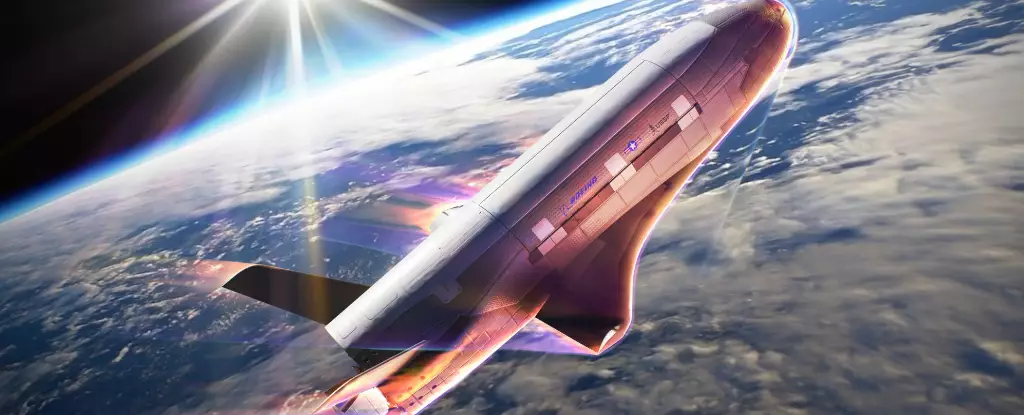The X-37B Orbital Test Vehicle (OTV), a remarkable feat of aerospace engineering developed by Boeing, continues to stoke curiosity and concern in equal measure since its inaugural flight in 2011. Operated by the United States Space Force (USSF), this reusable and remotely controlled spaceplane is uniquely designed for operations in Low-Earth Orbit (LEO), specifically between 240 and 800 kilometers above the Earth’s surface. With its latest mission, OTV-7, launched on December 29, 2023, the X-37B is focusing on a variety of experimental and strategic objectives while maintaining an air of secrecy around its true capabilities.
Among the most intriguing aspects of OTV-7 are the novel orbital maneuvers that the X-37B is set to engage in. These maneuvers include a groundbreaking technique called “aerobraking,” whereby the spacecraft grazes the upper atmosphere to decelerate and change its orbit, conserving fuel in the process. This is the first time the X-37B has employed such a tactic, which not only showcases the technical prowess of the USSF but also serves strategic purposes. The ability to perform complex maneuvers that evade detection offers a distinct advantage for military and exploratory missions, allowing the vehicle to conduct low passes under the radar of potentially hostile nations.
This innovative technique is a culmination of extensive research and experience, drawing on decades of aeronautical advancements and lessons learned from past missions to planetary bodies like the Moon and Mars. Significant examples include the Mars Global Surveyor, which successfully employed solar panels as control surfaces to navigate through the Martian upper atmosphere, as well as other missions such as the Mars Odyssey and ExoMars Trace Gas Orbiter. The insights gained from these projects have undeniably informed the design and operational capabilities of the X-37B.
The implications of the X-37B’s missions stretch far beyond mere experimentation. Officials from the USSF have emphasized that the vehicle’s capabilities serve crucial national security interests. Secretary of the Air Force Frank Kendall highlighted the importance of such maneuvers: “This series of innovative operations underlines the Space Force’s commitment to delivering groundbreaking achievements that bolster national security.” These remarks encapsulate the essence of the X-37B: a versatile tool not just for space exploration but as a vital component in the broader national defense strategy.
The ability to alter orbits in unpredictable patterns plays a significant role in avoiding detection by adversaries. Former U.S. Air Force Secretary Heather Wilson noted that the X-37B’s orbit resembles an egg shape, making it challenging for hostile nations to predict its trajectory. Such unpredictability complicates tracking defenses, particularly when the spacecraft maneuvers close to the atmosphere, thereby frustrating adversarial intelligence efforts.
Aside from its military applications, the X-37B is also conducting scientific experiments that could yield significant benefits for both space exploration and environmental science. The current mission includes tests on the impact of space radiation on various biological samples, specifically focusing on NASA’s “Seeds-2” experiment, which seeks to analyze the effects of space conditions on plant seeds. Such research could have profound implications for future long-duration human spaceflight and extraterrestrial colonization efforts.
Moreover, the X-37B is set to engage in experiments related to Space Domain Awareness (SDA) technologies that will advance the understanding and monitoring of space environments. As the complexities of space continue to evolve, maintaining situational awareness becomes increasingly essential not only for defense applications but also for ensuring the safety of civilian space operations.
Looking ahead, the advancements brought forth by the X-37B highlight the accelerating pace of innovation in space technologies. As the USSF aims to expand its operational capabilities, the success of the OTV-7 mission—and future missions—will likely influence how nations approach their space strategies and defense postures. The X-37B stands as a testament to American ingenuity and a harbinger of the intricate and potentially contentious dynamics that lie ahead in the ongoing exploration of outer space.
While much about the X-37B remains cloaked in secrecy, its multifaceted mission encapsulates the evolving interplay between military objectives and scientific inquiry, challenging assumptions about the purpose and potential of contemporary space technologies. As we continue to innovate and explore, one thing remains certain: the X-37B and its future missions will be of critical importance in shaping the landscape of space exploration and national security.


Leave a Reply